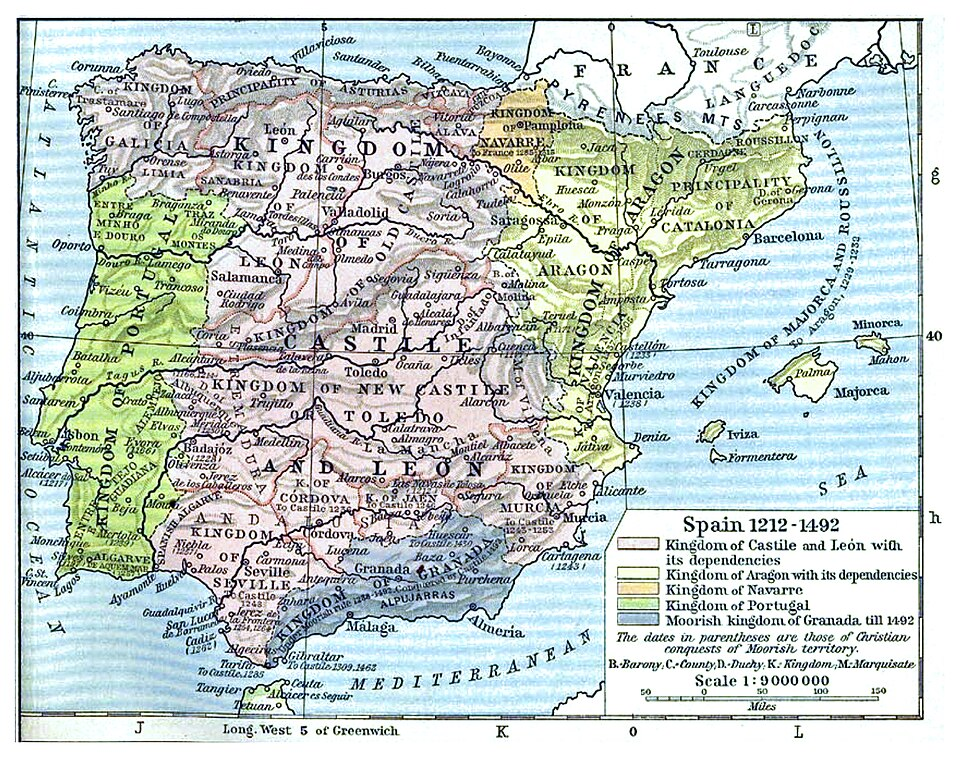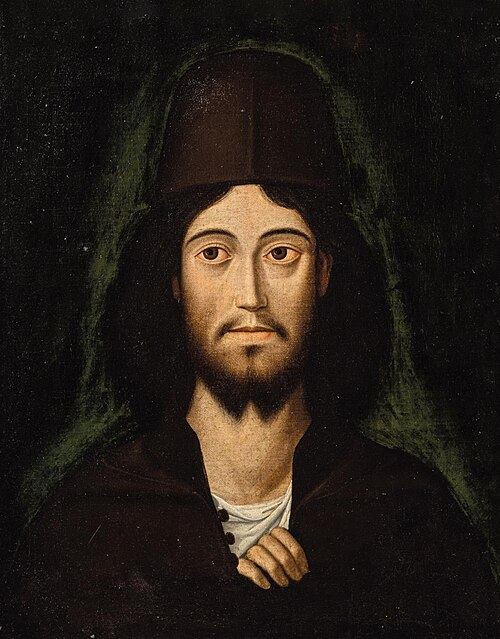IB Syllabus focus:
'The political structure and power dynamics in late 15th-century Iberia.
Internal conflicts within Granada and the role of alliances in shaping political outcomes.
The relationship between Christian kingdoms in Iberia and the Muslim state of Al-Andalus.'
The late 15th century was an epoch of transformation for Iberia, encapsulated by the simmering tensions between the unified Christian forces and the Muslim emirate of Granada or Al-Andalus. This period's intricate political landscape was deeply influenced by internal dynamics, alliances, and the overarching religious context.
Political Structure and Power Dynamics in Late 15th-century Iberia
Christian Kingdoms
Kingdoms of Castile and Aragón:
Historically, these were two of the most potent Christian kingdoms in Iberia.
Their union in 1469, through the marriage of Fernando de Aragón and Isabel de Castilla, created a formidable Christian front. Nonetheless, it's pivotal to understand that both kingdoms retained individual administrations and judicial systems till the early 16th century.
Power structures were predominantly monarchic. However, a balance of power was ensured through consultation with councils and regional assemblies known as Cortes which played a role in legislation and tax approval.
Other Christian Territories:
Besides Castile and Aragón, Iberia was also home to other Christian realms like the Kingdom of Navarre, the Kingdom of Portugal, and the Principality of Catalonia.

Political map of the Iberian Peninsula on the eve of 1492, highlighting Castile, Aragón (with Catalonia), Navarre, Portugal, and the Nasrid Emirate of Granada. This visual clarifies the balance of powers as the Catholic Monarchs consolidated their position while Granada remained the last Muslim stronghold. Source
These territories had distinct political systems, but the overarching influence of Castile and Aragón often determined their foreign policies and military engagements.
Al-Andalus (Muslim Granada)
Last Muslim Stronghold:
Granada's significance wasn't merely territorial; it represented the last beacon of seven centuries of Muslim rule in the Iberian Peninsula.
Under the Nasrid dynasty, Granada boasted a monarchy with nuances reminiscent of the Umayyad and Almoravid reigns in earlier centuries.
Palace Politics:
The Alhambra, a sprawling palace-cum-fortress, wasn't just an architectural marvel but the very hub of political manoeuvring in Granada.
Viziers (akin to prime ministers) held considerable sway, and their counsel significantly influenced the ruling monarch.
Internal Conflicts within Granada
Succession Disputes
The Nasrid dynasty, although long-standing, wasn't immune to the pitfalls of dynastic politics. Regular succession disputes ensued, often spilling into public arenas.
Rival factions, championing different would-be rulers, often sought external allegiances, further complicating the already fragile political fabric of Granada.
Alliances and Power Plays
Given Granada's vulnerable position, its monarchs often resorted to establishing strategic alliances, even if it meant siding with Christian rulers.
The ever-shifting loyalties are exemplified by the Nasrid ruler Muhammad XII, colloquially known as Boabdil. His tumultuous reign saw him incarcerated by the Castilians and later freed in a deal that traded his freedom for crucial territories.

Seventeenth-century portrait of Muhammad XII (Boabdil), the last Nasrid ruler of Granada, associated with factional strife and negotiated captivity during the war’s final phase. As an early-modern painting, it offers a later visual tradition rather than a contemporary image of Boabdil. Source
Relationship between Christian Kingdoms and Al-Andalus
Diplomacy and Alliances
The broader Reconquista narrative, while indicating a protracted Christian-Muslim conflict, doesn't encapsulate the numerous instances of truce, diplomacy, and mutual cooperation.
Given the fluid nature of medieval politics, alliances were often short-lived, predicated on immediate territorial or military gains.
Economic Dependencies
Trade Relations: Granada might have been politically isolated, but its economy was interlinked with Christian Iberia. Granada was a trade nexus for goods such as silk, dried fruits, spices, and artisanal crafts, ensuring a mutual economic dependency.
Military Engagements
The Christian kingdoms, driven by a mix of religious zeal and territorial ambitions, frequently mounted campaigns against Granada. Yet, it wasn't a linear tale of Christian advances; truces were negotiated, often brokered by pragmatism over religious orthodoxy.
Cultural Exchanges
The borders between Christian and Muslim territories were porous, not just for armies, but for scholars, merchants, and artisans. The Iberian Peninsula in the 15th century was a melting pot of Abrahamic cultures.
The scholastic resurgence in Christian Europe, often termed the Renaissance, was heavily indebted to the repositories of knowledge in Al-Andalus. Works in science, maths, astronomy, and medicine were translated from Arabic to Latin, paving the way for Europe's intellectual awakening.
Final Observations
The political dynamics of the late 15th century in Iberia were not just a prelude to the impending conclusion of the Reconquista in 1492 but were emblematic of the broader interplay between power, religion, and culture that had marked the Iberian Peninsula for centuries. Through alliances, warfare, trade, and scholarship, Christian Iberia and Muslim Granada forged a shared legacy that would resonate in the annals of history.
FAQ
Certainly, before Granada's prominence, the Iberian Peninsula was dotted with multiple Muslim states, often referred to as 'Taifas.' These were smaller emirates or kingdoms that emerged after the decline of the Umayyad Caliphate in the 11th century. Over the centuries, as the Christian Reconquista gained momentum, many of these Taifas either fell to Christian forces or were absorbed by more powerful Muslim empires like the Almoravids and Almohads. By the 13th century, as Christian forces captured key territories, including Cordoba and Seville, Granada, under the Nasrid dynasty, managed to maintain its sovereignty by becoming a tributary state and forming strategic alliances. Its geographical location, nestled in the Sierra Nevada mountains, further provided a natural defence, allowing it to remain as the last Muslim stronghold in Iberia by the late 15th century.
The Cortes, or regional assemblies, were pivotal in shaping the political landscape of the Christian kingdoms in the late 15th century. Predominantly constituted by nobles, clergy, and in some cases, representatives of towns, these assemblies held considerable legislative powers. They were not merely consultative bodies but had the authority to approve or reject royal proposals, especially concerning taxation. Their approval was crucial for the monarchs to finance wars or other royal endeavours. Hence, while monarchs like Isabel and Fernando wielded significant power, the Cortes acted as a balancing mechanism, ensuring that royal decisions were often in sync with broader regional interests.
Yes, cultural exchanges between Granada and the Christian kingdoms were profound, transcending the prevailing political and religious tensions. Granada, a repository of knowledge and scholarship from the Islamic Golden Age, became a crucial source for Christian scholars. The translation movement, particularly in places like Toledo, saw works on science, maths, medicine, and philosophy translated from Arabic to Latin, seeding the European Renaissance. Furthermore, artisans, architects, and musicians traversed these borders, leading to an amalgamation of styles, which can be seen in Mudejar art and architecture prevalent in Christian territories. This vibrant cultural synthesis underscores the porous nature of civilisational boundaries, even amidst conflict.
Throughout the 15th century, the relationship between Castile and Aragón was characterised by periods of cooperation, competition, and even conflict. Both kingdoms had their ambitions, but as the century progressed, the mutual benefits of a united front against Granada became increasingly evident. The real turning point was the marriage between Isabel of Castile and Fernando of Aragón in 1469, which was more than just a matrimonial alliance. It signified the fusion of two major Christian powers in Iberia. However, even after their union, both kingdoms retained distinct administrative and legal systems, reflecting the delicate balance of power and the preservation of regional identities.
The Alhambra, situated in Granada, was not just an architectural marvel but also the epicentre of political power during the late 15th century. Serving as the royal palace for the Nasrid monarchs, it became a symbolic representation of Muslim grandeur in Al-Andalus. Beyond its splendour, the Alhambra was the hub of decision-making, with councils, meetings, and diplomatic engagements often taking place within its walls. The intricate designs and water features within the palace itself were emblematic of the zenith of Muslim art and architecture. In essence, the Alhambra was both a tangible manifestation of Nasrid legacy and the beating heart of Granada's political life.
Practice Questions
Internal conflicts within Granada, primarily the succession disputes, significantly affected its relationship with the Christian kingdoms. The frequent dynastic infighting weakened Granada's political unity, rendering it more susceptible to external pressures. As various factions sought support, alliances were often formed with Christian monarchs, leading to a complex web of loyalties. These internal rifts not only facilitated Christian incursions but also led to tactical alliances, as seen with the incarceration and subsequent release of Boabdil. Thus, the internal strife in Granada inadvertently accelerated its eventual downfall by complicating its external relations during this crucial period.
During the late 15th century, despite religious and political antagonisms, a profound economic symbiosis existed between Granada and the Christian kingdoms. Granada, as the last Muslim bastion, was a pivotal trade hub, exporting goods like silk, dried fruits, and spices. These commodities were coveted by Christian kingdoms, leading to a reluctant economic interdependence. This mutual reliance implied that, while military and religious confrontations persisted, complete severance of ties was neither feasible nor desirable for either side. In essence, the economic interactions underscored a pragmatic dimension of their relationship, tempering extreme hostilities and offering moments of respite amidst the broader Reconquista narrative.

